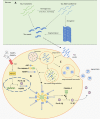Role of Microglial Cells in Alzheimer's Disease Tau Propagation
- PMID: 31636558
- PMCID: PMC6787141
- DOI: 10.3389/fnagi.2019.00271
Role of Microglial Cells in Alzheimer's Disease Tau Propagation
Abstract
Uncontrolled immune response in the brain contributes to the progression of all neurodegenerative disease, including Alzheimer's disease (AD). Recent investigations have documented the prion-like features of tau protein and the involvement of microglial changes with tau pathology. While it is still unclear what sequence of events is causal, it is likely that tau seeding potential and microglial contribution to tau propagation act together, and are essential for the development and progression of degenerative changes. Based on available evidence, targeting tau seeds and controlling some signaling pathways in a complex inflammation process could represent a possible new therapeutic approach for treating neurodegenerative diseases. Recent findings propose novel diagnostic assays and markers that may be used together with standard methods to complete and improve the diagnosis and classification of these diseases. In conclusion, a novel perspective on microglia-tau relations reveals new issues to investigate and imposes different approaches for developing therapeutic strategies for AD.
Keywords: Alzheimer’s disease; blood-brain barrier; inflammation; microglia; neurodegeneration; tau protein propagation.
Copyright © 2019 Španić, Langer Horvat, Hof and Šimić.
Figures


References
-
- Appel S., Beers D., Zhao W. (2014). Role of inflammation in neurodegenerative diseases. Neurobiol. Brain Dis. 380–395. 10.1016/B978-0-12-398270-4.00025-2 - DOI
LinkOut - more resources
Full Text Sources

